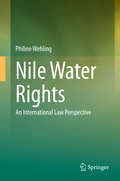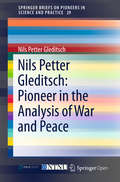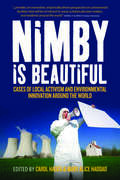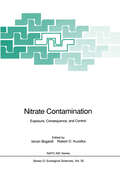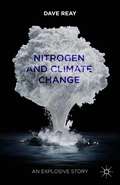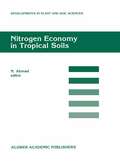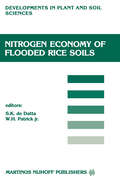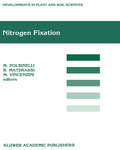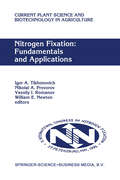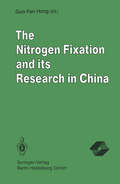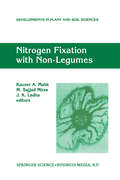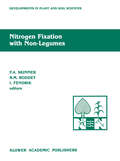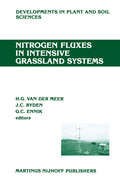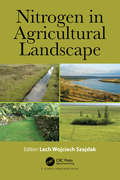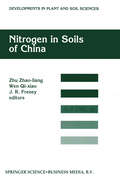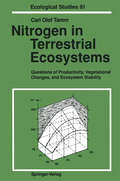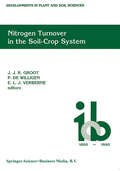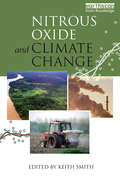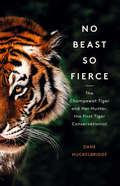- Table View
- List View
The Nile: History's Greatest River
by Terje TvedtThe greatest river in the world has a long and fascinating history. Professor Terje Tvedt, one of the world's leading experts on the history of waterways, travels upstream along the river's mouth to its sources. The result is a travelogue through 5000 years and 11 countries, from the Mediterranean to Central Africa. This is the fascinating story of the immense economic, political and mythical significance of the river. Brimming with accounts of central characters in the struggle for the Nile – from Caesar and Cleopatra, to Churchill and Mussolini, and on to the political leaders of today, The Nile is also the story of water as it nourished a civilization.
The Nile: History's Greatest River
by Terje TvedtThe greatest river in the world has a long and fascinating history. Professor Terje Tvedt, one of the world's leading experts on the history of waterways, travels upstream along the river's mouth to its sources. The result is a travelogue through 5000 years and 11 countries, from the Mediterranean to Central Africa. This is the fascinating story of the immense economic, political and mythical significance of the river. Brimming with accounts of central characters in the struggle for the Nile – from Caesar and Cleopatra, to Churchill and Mussolini, and on to the political leaders of today, The Nile is also the story of water as it nourished a civilization.
Nile Water Rights: An International Law Perspective
by Philine WehlingThe book provides a comprehensive assessment of the law governing the use and management of the Nile and considers, more broadly, how international water law can guide the development of a legal and institutional framework for cooperation over shared freshwater resources. It defines the current state of international water law and discusses the content of the United Nations Convention on the Law of the Non-Navigational Uses of International Watercourses. On this basis, it assesses the Nile water treaties and the 2010 Cooperative Framework Agreement for the Nile, and examines their compliance with international law, with a specific focus on the legal consequences of South Sudan's secession from Sudan. Moreover, the book recommends important amendments to the 2010 Agreement. Building on these recommendations, it addresses the implementation of the principle of equitable and reasonable use regarding the Nile, illustrating the extent to which the principle can provide a conceptual framework for regulating water use. The book is a valuable resource for academics and practitioners alike as it combines legal assessment with a discussion of how international water law principles can be implemented in practice.“Essential reading for anyone interested in understanding international law related to the Nile River basin, including its evolution, current challenges and future prospects.” - Professor Alistair Rieu-Clarke, Chair in Law, Law School, Northumbria University, Newcastle “A true must-read for anyone interested in the developing Nile River legal and institutional regime and in how to implement international water law principles and guidance at the transboundary river basin level. Most notably, the book operationalizes the principle of equitable use and applies it to the Nile, pointing the way forward for the cooperative management of the river’s resources.” - Stefano Burchi, Chairman of the Executive Council, International Association for Water Law (AIDA)
Nils Petter Gleditsch: Pioneer In The Analysis Of War And Peace (SpringerBriefs on Pioneers in Science and Practice #29)
by Nils Petter GleditschThis book presents Nils Petter Gleditsch, a staff member of the Peace Research Institute of Oslo (PRIO) since 1964, a former editor of the Journal for Peace Research (1983-2010), a former president of the International Studies Association (2008-2009) and the recipient of several academic awards as a pioneer in the scientific analysis of war and peace. This unique anthology covers major themes in his distinguished career as a peace researcher. An autobiographical, critical retrospective puts his work on conflict and peace into a broader context, while a comprehensive bibliography documents his publications over a period of nearly 50 years. Part II documents his wide-ranging contributions on globalization, democratization and liberal peace, on international espionage, environmental security, climate change and conflict and on the decline of war and more generally of violence as a tool in conflict.
Nimby Is Beautiful: Cases of Local Activism and Environmental Innovation around the World
by Carol Hager Mary Alice HaddadNIMBY (Not In My Back Yard) protests are often criticized as parochial and short-lived, generating no lasting influence on broader processes related to environmental politics. This volume offers a different perspective. Drawing on cases from around the globe, it demonstrates that NIMBY protests, although always arising from a local concern in a particular community, often result in broader political, social, and technological change. Chapters include cases from Europe, North America, and Asia, engaging with the full political spectrum from established democracies to non-democratic countries. Regardless of political setting, NIMBY movements can have a positive and proactive role in generating innovative solutions to local as well as transnational environmental issues. Furthermore, those solutions are now serving as models for communities and countries around the world.
Nitrate Contamination: Exposure, Consequence, and Control (Nato ASI Subseries G: #30)
by Wilma G. Ennenga Robert D. Kuzelka IstvanBogárdiThe nitrate content of drinking water is rising at an alarming rate in several regions of NATO countries and elsewhere in the world. The increase is due to lack of proper sewage treatment, and primarily to excess fertilizer application. Also, eutrophication in several coastal areas is triggered by high nitrate concentrations. The main purpose of this book is to integrate scientific knowledge related to exposure assessment, health consequences and control of nitrate contamination in water. The motivation is related to the magnitude, the possible adverse health effects, and the high cost of control ling nitrate contamination. Future research tasks are defined by an interaction among hydro logists, toxicologists and environmental engineers in an integrated framework for nitrate risk management. The target readership of this book is a mix of university colleagues, practitioners from both the private and public sectors and advanced graduate students working with the hydrological, health science or environmental engineering aspects of nitrate contamination. The main conclusions include: 1. For risk assessment purposes, knowledge and sufficiently accurate models are available to predict nitrate load and its fate in water under changes in land use. 2. Once agricultural exposure controls are implemented, the response times in ground water may be so long as to make controls unrealistic. 3. It is still unknown whether agricultural best management practice is a compromise between nitrate risk reduction and agricultural revenue. 4. The current drinking water guidelines of 10 mg/L NOrN need not be changed.
Nitrogen and Climate Change: An Explosive Story
by D. ReayThe world is changing. Human population is surging towards 10 billion, food, water, climate and energy security are all at risk. Nitrogen could be our life raft in this global 'perfect storm'. Get it right and it can help to feed billions, fuel our cars and put a dent in global warming. Get it wrong and it will make things a whole lot worse.
Nitrogen Economy in Tropical Soils: Proceedings of the International Symposium on Nitrogen Economy in Tropical Soils, held in Trinidad, W.I., January 9–14, 1994 (Developments in Plant and Soil Sciences #69)
by N. AhmadNitrogen Economy in Tropical Soils presents an authoritative and comprehensive state-of-the-art review on soil/plant nitrogen inter-relationships, with special reference to tropical soils and crops in aerobic and anaerobic environments. Use of isotopically labelled nitrogen in experimentation, especially in tropical environments, and recently developed analytical techniques for soil and plant materials are presented. An important aspect is the emphasis placed on the impact of the tropical environment on nitrogen transformations in the soil environment. This book should be an excellent source of information for senior undergraduate and graduate students with interest in soil/plant nitrogen inter-relationships, and for all levels of research workers in these fields.
Nitrogen Economy of Flooded Rice Soils: Proceedings of a symposium on the Nitrogen Economy of Flooded Rice Soils, Washington DC, 1983 (Developments in Plant and Soil Sciences #26)
by S. K. De Datta W. H. PatrickThe steadily increasing cost of nitrogen fertilizer has resulted in more emphasis on basic and applied studies to improve nitrogen use efficiency in lowland rice. The efficiency of fertilizer nitrogen in farmers' fields is shockingly low ~ a luxury resource-scarce farmers in tropical Asia can ill afford. We believe it is critical to quantify the basic transformation processes and develop management practices for higher N use efficiency for two reasons. They are: 1. Nitrogen fertilizer together with water management is a key factor for achieving the yield potentials of modern rices. 2. Fertilizer nitrogen prices are high and most Asian rice farmers are poor. The International Rice Research Institute (IRRI), Philippines; Internation al Fertilizer Development Center (IFDC), USA; Commonwealth Scientific and Industrial Research Organization (CSIRO), Australia; U.S. Universities (Louisiana, Cornell, California, Arkansas and others); and Dr Justus Leibig University in West Germany are actively engaged in individual or collaborative research that addresses basic transformation processes on N gains and losses and management practices to maximize N use efficiency in rice. It is appropriate to update and summarize, in a double issue of Fertilizer Research, the 10 papers presented at the special symposium organized by the American Society of Agronomy (ASA) at the 75th Annual Meeting in Washington, D.C. in 1983. S.K. De Datta, Head of Agronomy Department, IRRI, was chairman of the International Agronomy Division of ASA (A-6) in 1982 and 1983.
Nitrogen Fixation: Proceedings of the Fifth International Symposium on Nitrogen Fixation with Non-Legumes, Florence, Italy, 10–14 September 1990 (Developments in Plant and Soil Sciences #48)
by M. Polsinelli R. Materassi M. VincenziniThe Fifth International Symposium on Nitrogen Fixation with Non-legumes was held in Florence (Italy) on 10-14 September, 1990. Earlier Symposia of this series were held in Piracicaba (Brazil), Banf Alberta (Canada), Helsinki (Finland) and Rio De Janeiro (Brazil). The Symposium's main objectives were to bring together scientists working in many different fields of nitrogen fixation, to stimulate discussion on this important process and to have an appraisal of the most recent studies concerning nitrogen fixation with non-legumes. The Symposium was attended by 230 scientists from 32 different countries. This volume collects the contributions of 65 lectures and 87 posters, which are an up-to-date account of the state of knowledge on biological nitrogen fixation with non-legumes. The book provides a valuable reference source not only for specialists in nitrogen fixation, but also for researchers working on related aspects of agronomy, biochemistry, genetics, microbiology, molecular biology and plant physiology. It is with great pleasure that we aknowledge the contributions of the authors in assuring the prompt pubblication of this volume. We would also like to express our thanks to Kluwer Academic Publishers B.V. for the publication of these Proceedings. M. Polsinelli R. Materassi M. Vincenzini ORGANIZING COMMITTEE President M. Polsinelli M. Vincenzini Secretary F. Favilli Treasurer E. Galli E. Gallori L. Giovannetti R. Materassi M.P. Nuti M.R. Tredici SCIENTIFIC COMMITTEE M. Bazzicalupo Florence, Italy H. Bothe Cologne, West Germany R.H. Burris Madison, U.S.A.
Nitrogen Fixation: Proceedings of the 10th International Congress on Nitrogen Fixation, St. Petersburg, Russia, May 28—June 3, 1995 (Current Plant Science and Biotechnology in Agriculture #27)
by Igor A. Tikhonovich Nikolai A. Provorov Vassily I. Romanov William E. NewtonNitrogen fixation research is presented as a rapidly developing, synergistic area of modern science, using the methods of, and accumulating data from, many fundamental branches of biology and chemistry. These include catalytic mechanisms, protein structure and function, molecular organization of genes and the regulation of their activities, biochemistry of plants and microorganisms, the signalling and surface interactions between organisms, microbial taxonomy and evolution, formal and population genetics, and ecology. The relationships between biological nitrogen fixation research and different branches of applied biology are addressed and analyzed, such as: the monitoring of genetically engineered microorganisms, selection of plant-associated microbes, plant breeding, increasing the protein content of crops, providing ecologically safe food production, and diminishing the chemical pollution of the environment. Immediate impacts and long-term prospects for nitrogen fixation research are presented: both fundamentals and applications.
The Nitrogen Fixation and its Research in China
by Guo-Fan HongNitrogen Fixation by symbiotic organisms is considered an important contribution to the solution of food problems throughout the world. For manyyears, Chinese scientists have focused their research in this area. Today more than half of the total nitrogen fertilizers applied are from biological fixation sources. The editor is an international renowned scientist at the Chinese Academy of sciences. He has brought together contributions from various research fields in China and Europe.Together they present the state-of-the-art in nitrogen-fixation research. The studies range from actino- mycete fixation induced in various genera andspecies of plants, mechanisms and chemical modeling of enzyme systems togenetical engineering of organisms.
Nitrogen Fixation with Non-Legumes: Proceedings of the 7th International Symposium on Nitrogen Fixation with Non-Legumes, held 16–21 October 1996 in Faisalabad, Pakistan (Developments in Plant and Soil Sciences #79)
by K. A. Malik M. Sajjad Mirza J. K. LadhaDiazotrophic bacteria convert atmospheric nitrogen to plant-useable form and this input of nitrogen through biological fixation is of great agronomic importance. The contributions presented in this volume relate to free-living nitrogen fixers and the diazotrophs associated with plants. Symbiotic association of Frankia with non-legumes and cyanobacterial associations are also discussed. Research topics covered in this volume include the biochemistry and genetics of diazotrophs, recent developments in improvement of plant-microbe interactions and their molecular basis, the use of molecular probes in taxonomy and ecology of diazotrophs and reports on field applications, agronomic importance and improvement in methodologies for assessing their contribution to plants. This book provides valuable information not only for researchers working in the field of biological nitrogen fixation but also for biochemistry, molecular biologists, microbiologists and agronomists.
Nitrogen Fixation with Non-Legumes: The Fourth International Symposium on ‘Nitrogen Fixation with Non-Legumes’, Rio de Janeiro, 23–28 August 1987 (Developments in Plant and Soil Sciences #35)
by F. A. Skinner Robert M. Boddey I. FendrikProceedings of the 4th International Symposium on Nitrogen Fixation with Non-Legumes, Rio de Janeiro, Brazil, August 23-28, 1987
Nitrogen Fluxes in Intensive Grassland Systems (Developments in Plant and Soil Sciences #23)
by H. G. Van Der Meer J. C. Ryden G. C. EnnikNitrogen in Agricultural Landscape
by Lech Wojciech SzajdakAgriculture transforms the environment. The simplification of agroecosystems structure increases the hazards of leaching, wind and water erosion, and volatilization of chemicals from soil. Soil nitrogen is of interest as a major crop nutrient, but also as a potential environmental pollutant. Knowledge about the behavior of soil nitrogen is desirable in order to optimize plant growth and crop yield and to minimize environmental side effects. This book also gives information about the function of biogeochemical barriers in the form of shelterbelts, which efficiently decrease the concentrations of various forms of nitrogen in ground water.
Nitrogen in Agricultural Landscape
by Lech Wojciech SzajdakAgriculture transforms the environment. The simplification of agroecosystems structure increases the hazards of leaching, wind and water erosion, and volatilization of chemicals from soil. Soil nitrogen is of interest as a major crop nutrient, but also as a potential environmental pollutant. Knowledge about the behavior of soil nitrogen is desirable in order to optimize plant growth and crop yield and to minimize environmental side effects. This book also gives information about the function of biogeochemical barriers in the form of shelterbelts, which efficiently decrease the concentrations of various forms of nitrogen in ground water.
Nitrogen in Soils of China (Developments in Plant and Soil Sciences #74)
by Zhu Zhu Zhao-Liang Wen Wen Qi-Xiao J. R. FreneyThe study of soil nitrogen has long been an active field, but it was generally pivoted on agricultural and forestry production, and animal husbandry. With the rapid increase in the use of fertilizer nitrogen, more attention has been paid to the rela tionship between nitrogen management and environmental quality and human of soil nitrogen has become more comprehensive with health. In addition, the study the development of related sciences. The quantitative study of the processes in nitrogen cycling and their interrelationships has been an important part of this project and has attracted the attention of scientists allover the world. Nitrogen is one of the most important nutrients for plant growth and the applica tion of fertilizer nitrogen is playing an important role in agricultural production. The annual consumption of fertilizer nitrogen in the world has reached 70 million tons, and China has an annual consumption of more than 15 million tons and is the largest fertilizer nitrogen consumer in the world. However, the efficiency of nitro gen fertilizer is low and losses are large. It is estimated that nitrogen losses from agriculture in our country can be as high as 40-60% of the nitrogen applied. Some of the lost nitrogen enters the atmosphere and contributes to the greenhouse effect and some enters water bodies to pollute the water.
Nitrogen in Terrestrial Ecosystems: Questions of Productivity, Vegetational Changes, and Ecosystem Stability (Ecological Studies #81)
by Carl O. TammNitrogen is a key element in ecosystem processes. Aspects of local and global changes in nitrogen in both undisturbed and disturbed conditions are discussed. Environmental changes caused by pollution from nitrogenous compounds and changes in landuse are also described. Organisms, plants, animals and microorganisms are all affecting nitrogen supply. Emphasis is placed on natural and anthropogenic transfer of nitrogen between ecosystems and also on the interaction of nitrogen with other bioelements.
Nitrogen Turnover in the Soil-Crop System: Modelling of Biological Transformations, Transport of Nitrogen and Nitrogen Use Efficiency. Proceedings of a Workshop help at the Institute for Soil Fertility Research, Haren, The Netherlands, 5–6 June 1990 (Developments in Plant and Soil Sciences #44)
by J. J. Groot P. De Willigen E. J. VerberneIn the Netherlands the Institute for Soil Fertility Research plays a major role in soil biological, soil physical and plant nutritional research on the availability of nitrogen to crops. Main subjects of research are nitrogen turnover in the crop-soil ecosystem through biological transformations, nitrogen transport through the soil and nitrogen losses by leaching, denitrification and volatilization, and nitrogen use efficiency of various crops and cropping systems. The current knowledge in the different fields of research is integrated in simulation models. Simulation models not only make it possible to summarize and structure knowledge, but also, after verification, to extra- late the knowledge to situations different from the situations that have actually been studied. Such research is also carried out in other European and non-European countries. To compare the various simulation models currently in use, a workshop was organized by the Institute for Soil Fertility Research on 5-6 June 1990 on the occasion of its centennial. The title of the workshop was 'Nitrogen turnover in the soil-crop ::cosystem: modelling of biological transformations, transport of nitrogen and nitrogen use efficiency'. The 40 Jarticipants, who came from Canada and various European countries, were requested to run their model with data Jrovided by the Institute prior to the workshop. Data from 18 cases were made available to the participants: three ocations, three treatments, and two seasons.
Nitrous Oxide and Climate Change
by Keith SmithNitrous oxide, N2O, is the third most important (in global warming terms) of the greenhouse gases, after carbon dioxide and methane. As this book describes, although it only comprises 320 parts per billion of the earth's atmosphere, it has a so-called Global Warming Potential nearly 300 times greater than that of carbon dioxide. N2O emissions are difficult to estimate, because they are predominantly biogenic in origin. The N2O is formed in soils and oceans throughout the world, by the microbial processes of nitrification and denitrification, that utilise the reactive N compounds ammonium and nitrate, respectively. These forms of nitrogen are released during the natural biogeochemical nitrogen cycle, but are also released by human activity. In fact, the quantity of these compounds entering the biosphere has virtually doubled since the beginning of the industrial age, and this increase has been matched by a corresponding increase in N2O emissions. The largest source is now agriculture, driven mainly by the use of synthetic nitrogen fertilisers. The other major diffuse source derives from release of NOx into the atmosphere from fossil fuel combustion and biomass burning, as well as ammonia from livestock manure. Some N2O also comes directly from combustion, and from two processes in the chemical industry: the production of nitric acid, and the production of adipic acid, used in nylon manufacture. Action is being taken to curb the industrial point-source emissions of N2O, but measures to limit or reduce agricultural emissions are inherently more difficult to devise. As we enter an era in which measures are being explored to reduce fossil fuel use and/or capture or sequester the CO2 emissions from the fuel, it is likely that the relative importance of N2O in the 'Kyoto basket' of greenhouse gases will increase, because comparable mitigation measures for N2O are inherently more difficult, and because expansion of the land area devoted to crops, to feed the increasing global population and to accommodate the current development of biofuels, is likely to lead to an increase in N fertiliser use, and thus N2O emission, worldwide. The aim of this book is to provide a synthesis of scientific information on the primary sources and sinks of nitrous oxide and an assessment of likely trends in atmospheric concentrations over the next century and the potential for mitigation measures.
Nitrous Oxide and Climate Change
by Keith SmithNitrous oxide, N2O, is the third most important (in global warming terms) of the greenhouse gases, after carbon dioxide and methane. As this book describes, although it only comprises 320 parts per billion of the earth's atmosphere, it has a so-called Global Warming Potential nearly 300 times greater than that of carbon dioxide. N2O emissions are difficult to estimate, because they are predominantly biogenic in origin. The N2O is formed in soils and oceans throughout the world, by the microbial processes of nitrification and denitrification, that utilise the reactive N compounds ammonium and nitrate, respectively. These forms of nitrogen are released during the natural biogeochemical nitrogen cycle, but are also released by human activity. In fact, the quantity of these compounds entering the biosphere has virtually doubled since the beginning of the industrial age, and this increase has been matched by a corresponding increase in N2O emissions. The largest source is now agriculture, driven mainly by the use of synthetic nitrogen fertilisers. The other major diffuse source derives from release of NOx into the atmosphere from fossil fuel combustion and biomass burning, as well as ammonia from livestock manure. Some N2O also comes directly from combustion, and from two processes in the chemical industry: the production of nitric acid, and the production of adipic acid, used in nylon manufacture. Action is being taken to curb the industrial point-source emissions of N2O, but measures to limit or reduce agricultural emissions are inherently more difficult to devise. As we enter an era in which measures are being explored to reduce fossil fuel use and/or capture or sequester the CO2 emissions from the fuel, it is likely that the relative importance of N2O in the 'Kyoto basket' of greenhouse gases will increase, because comparable mitigation measures for N2O are inherently more difficult, and because expansion of the land area devoted to crops, to feed the increasing global population and to accommodate the current development of biofuels, is likely to lead to an increase in N fertiliser use, and thus N2O emission, worldwide. The aim of this book is to provide a synthesis of scientific information on the primary sources and sinks of nitrous oxide and an assessment of likely trends in atmospheric concentrations over the next century and the potential for mitigation measures.
No Bear Anywhere
by Leah GilbertA young boy learns to cope with disappointment and embrace the unexpected in this infectiously charming, beautifully illustrated picture book.When his family takes a walk on Bear Creek Trail, Bruin is determined to spot his favorite animal (a bear). Before too long, he notices something! It's a . . . pinecone! Not a bear, but that's okay. A few minutes later, Bruin stops again: He's seen a . . . flower! No bear anywhere, but there's still plenty of time. Eventually, they make it all the way to the . . . cave! But when there is no bear anywhere in the cave, Bruin is as sad as could be. Can he turn his day around, even when there's no bear? Or, wait a minute-was a bear there, after all?! Leah Gilbert's gorgeous art shines in this playful and charming story about finding wonder and joy in the world around us, even when life takes unexpected turns.
No Bear Anywhere
by Leah GilbertA young boy learns to cope with disappointment and embrace the unexpected in this infectiously charming, beautifully illustrated picture book.When his family takes a walk on Bear Creek Trail, Bruin is determined to spot his favorite animal (a bear). Before too long, he notices something! It's a . . . pinecone! Not a bear, but that's okay. A few minutes later, Bruin stops again: He's seen a . . . flower! No bear anywhere, but there's still plenty of time. Eventually, they make it all the way to the . . . cave! But when there is no bear anywhere in the cave, Bruin is as sad as could be. Can he turn his day around, even when there's no bear? Or, wait a minute-was a bear there, after all?! Leah Gilbert's gorgeous art shines in this playful and charming story about finding wonder and joy in the world around us, even when life takes unexpected turns.
No Beast So Fierce: The Terrifying True Story Of The Champawat Tiger, The Deadliest Animal In History
by Dane HuckelbridgeThe deadliest animal of all time meets the world's most legendary hunter in a classic battle between man and wild. But this pulse-pounding narrative is also a nuanced story of how colonialism and environmental destruction upset the natural order, placing man, tiger and nature on a collision course.

